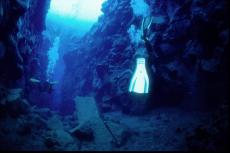Sea turtles’ magnetic sense
Migratory sea turtles are capable of sensing longitude, using almost imperceptible gradients in Earth’s magnetic field. A variety of animals regularly return to relatively precise locations after migration or displacement, homing pigeons being perhaps the best known example.
This behaviour seems to imply a map sense from which the creatures read either absolute or relative location from at least two coordinates. The direction is one thing but how about the position?
Latitude is fairly simple to judge, and there is good evidence that animals have this variable well under control. The elevation of the pole point at night, for example, gives the latitude directly; memorizing the constellations allows at least some species to infer the pole point through broken clouds.
The hard problem
Longitude, by contrast, is very much harder to determine. The essential problem (at least as our species conceives it) is in determining the local time and comparing it to the time at the reference longitude. The most promising time-independent idea was first floated more than 300 years ago: longitude might be encoded in systematic variations in the Earth’s magnetic field.
Those differences, however, are far greater by latitude than by longitude. Travel north or south from Earth’s magnetic poles and their pull weaken noticeably. Travel straight east or west, and the pull doesn’t change. Instead, the pull’s angle changes, and only to an infinitesimally slight degree. That turtles and other migratory animals could detect such a small change was considered unrealistic, but experiments on animals released in out-of-the-way locations repeatedly described them finding home with unerring accuracy and efficiency, explicable only as a product of both longitudinal and latitudinal awareness.
Magnetic map
We have known for about six years now that the magnetic map of turtles, at a minimum, allows turtles to detect latitude magnetically,” said biologist Ken Lohmann of the University of North Carolina, who described the turtle’s power in Current Biology, February 24. “Up until now, that was where the story ended,” he said.
Several nonmagnetic explanations were proposed, foremost among them, a “dual clock” mechanism analogous to human methods of calculating longitude, which sailors perform by comparing precise differences between the time locally and at an arbitrary longitudinal line, such as the Green-wich Meridian. No such mechanism has been found, however.
Putting it to the test
Researchers led by Lohmann, placed hatchling loggerhead sea turtles from Florida inside pools of water surrounded by computer-controlled magnetic coil systems. By varying the currents, Lohmann and Putnam could precisely reproduce the geomagnetic characteristics of two points at identical latitude, but on opposite sides of the Atlantic. Into each pool, they placed the hatchlings, which in the wild would instinctively follow a migratory path from their home beach and into the currents that circle the Sargasso Sea and loop around the Atlantic. Turtles exposed to a field like one that exists on the west side of the Atlantic near Puerto Rico swam approximately northeast. Those exposed to a field like one that exists on the east side of the Atlantic near the Cape Verde Islands swam approximately southwest.
The results demonstrate for the first time that longitude can be encoded into the magnetic positioning system of a migratory animal. Because turtles also assess north-south position magnetically, the findings imply that loggerheads have a navigational system that exploits the Earth’s magnetic field as a kind of bicoordinate magnetic map from which both longitudinal and latitudinal information can be extracted.
- Log in to post comments

























